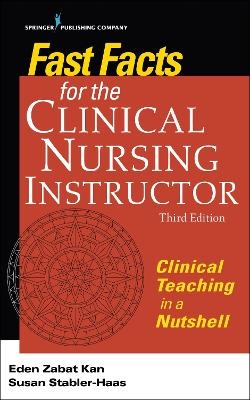
Fast Facts for the Clinical Nursing Instructor
Springer Publishing Co Inc (Verlag)
978-0-8261-4007-4 (ISBN)
- Titel erscheint in neuer Auflage
- Artikel merken
Newly expanded and updated with a wealth of practical information, the third edition of this bestselling Fast Facts guide offers pragmatic advice on how to tailor teaching to nurses in different clinical sites, specialties, and student populations; and addresses new requirements regarding online learning and hospital electronic documentation. Providing concrete tools for anxiety and stress reduction, the third edition also focuses on the importance of self-care.
Following the instructor from day one through an entire rotation, the book helps readers to organize the clinical experience, develop effective relationships with staff at clinical facilities, make clinical assignments, plan orientation days, develop clinical rotations, and understand relevant legal issues. It covers key information about policies and procedures, from school to clinical site. Delivered in a concise, quick-access, easy-to-read format, the book helps both new and experienced instructors to optimize the learning experience for their students.
New to the Third Edition:
Describes how to tailor teaching to various clinical sites, specialties, and different student populations
Provides helpful stress- and anxiety-reduction tools for instructors and their students
Covers the requirements of online learning and hospital electronic documentation
Highlights ways to retain clinical faculty
Key Features:
Disseminates practical information in concise, quick-access ""Fast Facts"" style
Useful for both novice and experienced clinical instructors
Describes what every clinical instructor needs to know about policies and procedures, from school to clinical site.
Discusses documentation and student evaluations, student clinical conferences, and NCLEX preparation
Reviews legal issues, including confidentiality and patient privacy
Eden Zabat Kan, PhD, RN, is Assistant Professor, Nursing Department, Health Sciences Division, The College of Southern Maryland, where she is responsible for didactic and clinical instruction for first semester students. Dr. Kan received her bachelor's degree in nursing from the Penn State University at State College, PA., her master’s degree in nursing education from Villanova University, Villanova, PA, and her doctorate in nursing science from Widener University, Chester, PA. Susan Stabler-Haas, PMHCNS-BC, RN is a clinical nursing instructor at Villanova University, PA. She has over 30 years of classroom and clinical teaching experience in the areas of medical-surgical, critical care, geriatric, and psychiatric nursing. Her instruction is influenced by her prior roles as staff nurse, rehab nurse, and critical care nurse manager in five Philadelphia area hospitals. Professor Stabler-Haas has earned a psychiatric clinical nurse specialist designation from the University of Pennsylvania. She is a licensed marriage and family therapist, a trained Mindfulness-Based Meditation teacher, and author of Fast Facts for the Student Nurse.
Contents
Preface
Acknowledgments
Introduction
Part I APPRECIATING YOUR NEW IDENTITY: FROM CAREGIVER TO EDUCATOR
1. Developing a New Identity as a Clinical Nursing Instructor
2. Understand the Rules: What Every Nursing Instructor Needs to Know About the Nursing Program’s Policies
3. Your New World: Clinical Sites, Clinical Specialties, Clinical Students
Part II YOUR SUCCESS DEPENDS ON YOU: PREPARING FOR YOUR CLINICAL TEACHING ASSIGNMENT
4. You Are a Guest, So Act Like One
5. Organize the Semester—Have a Plan
6. Confidentiality and Patient Privacy
Part III GETTING TO KNOW YOUR NURSING STUDENTS: WHO ARE THE BEST AND WHO ARE THE REST?
7. The High Fliers: How to Screen for Higher Achieving Students
8. The Not-So-High Fliers: How to Screen for Potential “Problem Students”
Part IV THE PERFORMANCE APPRAISALS: CLINICAL EVALUATIONS
9. The Clinical Evaluation Triad
10. The Dos and Don’ts of Student Documentation
11. Early Warning System
12. Graded Clinical Versus Pass/Fail Evaluations
Part V MANAGING THE CLINICAL DAY
13. Preconferences
14. Postconferences
15. Unplanned Events and Absences
16. Alternative Assignments
17. Unsafe Practice
Part VI SATISFACTION IN THE ROLE
18. What Your Students Will Expect of You
19. Take Time for Self-Care
Part VII OF GROWING IMPORTANCE
20. Letters of Reference
21. Role of Simulation
Appendices
A. An Example of Guidelines for Clinical Orientation Day
B. Clinical Journal: NSL/NSG 423
C. 4 C Clinical Assignment Sheet
D. Student Report Sheet
E. One-Minute Breathing Space
F. Sample Letters of Reference
Bibliography
Index
| Erscheinungsdatum | 12.10.2017 |
|---|---|
| Verlagsort | New York |
| Sprache | englisch |
| Maße | 133 x 197 mm |
| Gewicht | 260 g |
| Themenwelt | Medizin / Pharmazie ► Pflege ► Ausbildung / Prüfung |
| Pflege ► Fachpflege ► Anästhesie / Intensivmedizin | |
| ISBN-10 | 0-8261-4007-6 / 0826140076 |
| ISBN-13 | 978-0-8261-4007-4 / 9780826140074 |
| Zustand | Neuware |
| Informationen gemäß Produktsicherheitsverordnung (GPSR) | |
| Haben Sie eine Frage zum Produkt? |
aus dem Bereich



